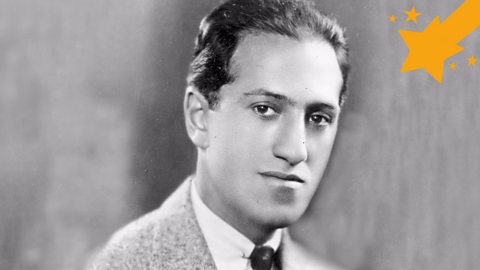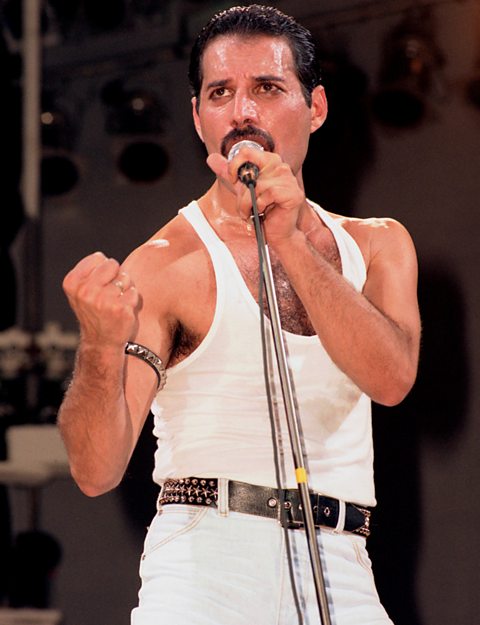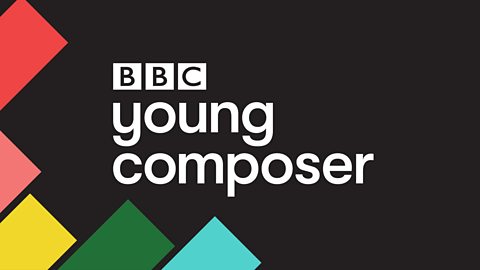- Learn about composer George Gershwin and Rhapsody in Blue.
- Explore improvising using the blues scale.
- Follow steps to compose your own rhapsody.

Writing music about the world around you
Musicians often take inspiration from the world around them.
George Gershwin’s Rhapsody in Blue is a famous piece that is based on the sounds of everyday life in a big city.
It is performed by piano and orchestra and uses the blues scale and rhythms inspired by ragtime and dance music.
It was one of the first pieces to blend jazz and classical styles and Gershwin composed it while he was on a train.

Did you know?
It has become a symbolic piece about New York and features in several films such as Fantasia and The Great Gatsby.
Watch this video to find out why Rhapsody in Blue is such an exciting piece of music.
Radzi Chinyanganya introduces George Gershwin's Rhapsody in Blue and tells us about Gershwin’s love of jazz and blues.

What is a rhapsody?
A rhapsody is a piece of music in one movement which has several sections. It explores a range of feelings in each section.
The structure could be described as ABCD - it has four different sections without repeating. This is different to some song structures such as verse, chorus, verse, chorus - ABAB.
Another example of a rhapsody is Bohemian Rhapsody by Queen. It contains lots of different musical ideas such as a capella group singing, gentle piano ballads and fast, loud rock guitar.

Compose your own rhapsody
Follow these steps to make your own composition using one instrument, your voice and a recording device.
You will use improvisation, the blues scale and the rhapsody structure.
1. Create some sounds
Make up three simple short musical ideas inspired by things you hear during the day - one in the morning, one in the middle and one at the end of the day.
- Listen for ideas from around home, around school or when you are outside.
- Capture rhythms you hear with taps, claps or clicks.
- Make a melody based on these sounds using your voice to sing or hum.
- Record these sounds (on a phone, computer or other recording device).

2. Make a melody using the blues scale
Develop the ideas from Task 1 using the blues scale.
- Play C major - on a keyboard play the white notes between C and the C above.
- Play a blues version of this scale - “flatten” the 3rd, 5th and 7th note by playing the black notes to the left. Skip the D and the A.
Watch this video of a C major scale on a piano.

Watch a blues scale in C played on the piano.
Play these up and down a few times so that you can hear what the blues scale in C sounds like.
Make melodies on the blues scale based on the sounds you created in Task 1. It can be one or two bars.
3. Develop your ideas
Top tip: Improvising is making up new musical ideas as you play and it's a great way to help you compose!
Use improvisation to develop your melodies further. Repeat your melody but improvise by trying something different each time:
- Change the tempo - try it slower or quicker.
- Play it backwards.
- Remove, add or repeat one or two notes.
Try using one of Gershwin’s rhythms.
Here is the rhythm from the train section in Rhapsody in Blue.
Can you hear how Gershwin uses this rhythm to represent the movement of the train?
It uses syncopation - rhythm patterns where stressed notes are placed off the beat.
Watch this section of Gershwin's Rhapsody in Blue and listen for the syncopated rhythm of the train played on the piano. Pianist Lauren Zhang joins the ±«Óătv Scottish Symphony Orchestra to perform Gershwin’s Rhapsody in Blue.


4. Bring it together
Now you bring it all together to make one piece.
- Link your patterns to create a longer phrase.
- Try out a few different combinations and decide on the order you like best.
- Make a beginning and an ending. The introduction can be the sound of morning, and the end could be the sound of the end of your day.
- Use the rhapsody structure to go on a journey ABC. You can add more sections if you like.

Record your music
When you have finished, create a recording:
- Export your track from the music software.
- Record instruments playing your piece.
- Make a video, putting your music to the film.
Send your music to the ±«Óătv
When you have finished your composition, you can send your music to ±«Óătv Young Composer competition.
If you love making your own original music, then why not enter the ±«Óătv Young Composer competition? It is open for everyone aged 12-18.

Play Bitesize secondary games. game
Have fun playing science, maths, history, geography and language games.

More on Composing with Ten Pieces
Find out more by working through a topic